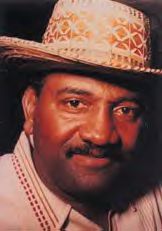Tite Curet Alonso facts for kids
Quick facts for kids
Catalino "Tite" Curet Alonso
|
|
|---|---|
 |
|
| Background information | |
| Born | February 12, 1926 Guayama, Puerto Rico |
| Died | August 5, 2003 (aged 77) Baltimore, Maryland, US |
| Genres | Salsa |
| Occupation(s) | Composer |
Catalino "Tite" Curet Alonso (born February 12, 1926 – died August 5, 2003) was a famous Puerto Rican composer. He wrote over 2,000 salsa songs! Many of his songs became huge hits for other artists.
Contents
Early Life and Influences
Catalino Curet Alonso was born in Guayama, a town in the southern part of Puerto Rico. His mother was a seamstress, and his father was a Spanish language teacher and musician. When Tite was two years old, his parents separated. He moved with his mother and sister to Barrio Obrero in Santurce, a part of San Juan. His grandmother helped raise him there.
Living in Barrio Obrero greatly shaped his music. He went to school there and wrote his first song when he was 15. Some of his childhood friends became famous musicians too, like Rafael Cortijo and Ismael Rivera.
Becoming a Song Composer
After high school, Tite Curet Alonso studied journalism and sociology at the University of Puerto Rico. He also worked for the United States Postal Service for over 20 years. All this time, he kept writing songs.
In 1960, he moved to New York City. There, he worked as a sports writer for a newspaper called "Diario/La Prensa." In 1965, he met Joe Quijano, a salsa singer. Joe recorded Tite's song Efectivamente, and it became a big hit!
Tite Curet Alonso created a special style of music. People called it "salsa with a conscience." He wrote songs about social issues and love. Many of his songs talked about the lives of poor Afro–Puerto Ricans and the challenges they faced. He also celebrated the beauty of black people from the Caribbean.
Throughout his life, Tite Curet Alonso wrote more than 2,000 songs. About 200 of these were hit songs, and around 50 were major salsa hits! Many famous singers performed his music. Some of them include Cheo Feliciano, Celia Cruz, Willie Colón, Héctor Lavoe, Rubén Blades, and Tito Puente. His song Las Caras Lindas (De Mi Gente Negra) (which means "The Beautiful Faces (Of My Black People)") was sung by Ismael Rivera. Many people in Puerto Rico consider it a classic. Besides salsa, Tite Curet Alonso also wrote samba songs.
Later Years and Challenges
Tite Curet Alonso got married and had a daughter and a son. However, his marriage did not last. Even though his songs sold millions of copies, he didn't earn much money from them. His family said he signed contracts that mostly helped the recording studios and a company called "ACEMLA."
For many years, his music was not played on Puerto Rican radio stations. This was because ACEMLA, a music publishing company, sued many places for using his songs without their permission. This included radio and TV stations, and even churches. In 2009, a US Federal Court allowed 695 of his songs to be used again. But legal battles over his other songs continued.
His Lasting Legacy
Tite Curet Alonso passed away on August 5, 2003, from a heart attack in Baltimore, Maryland. His friends, Richie Viera and William Nazaret, made sure his body was brought back to Puerto Rico.
He received a special state funeral in Puerto Rico. His wake was held at the Institute of Puerto Rican Culture and then at the Capitol building in San Juan. Finally, he was buried in the Santa Maria Magdalena de Pazzis Cemetery in Old San Juan. Many famous people attended his funeral, including Rubén Blades and Cheo Feliciano.
In 2009, a collection of his music called Alma de Poeta (meaning "Soul of a Poet") was released. It had two discs of his songs. Today, a life-sized statue of Tite Curet Alonso sits on his favorite bench in San Juan's Plaza de Armas, honoring his memory.
See also
 In Spanish: Tite Curet Alonso para niños
In Spanish: Tite Curet Alonso para niños
- List of Puerto Ricans
- List of Puerto Ricans of African descent
- List of Puerto Rican songwriters

